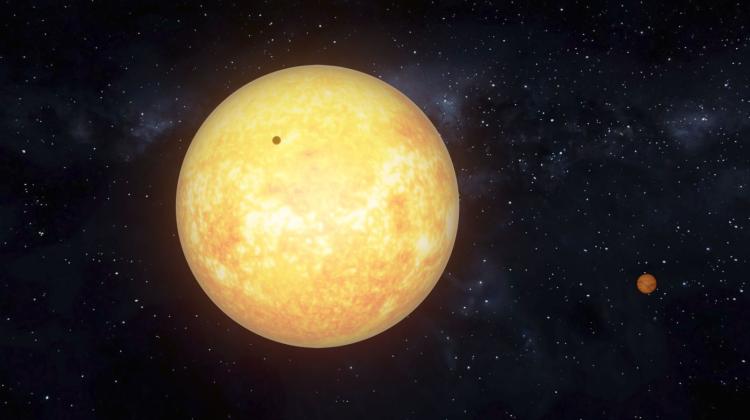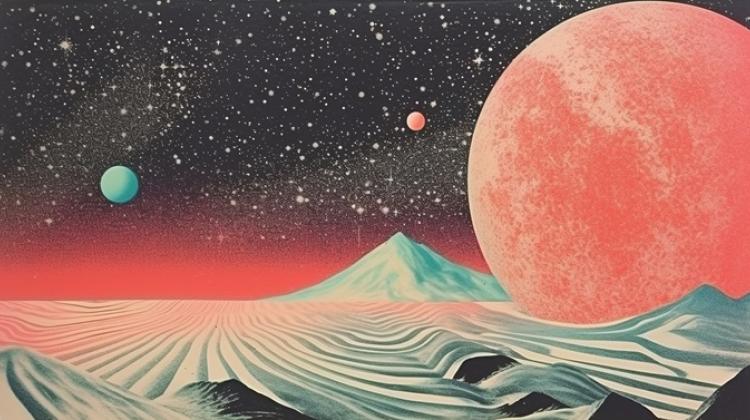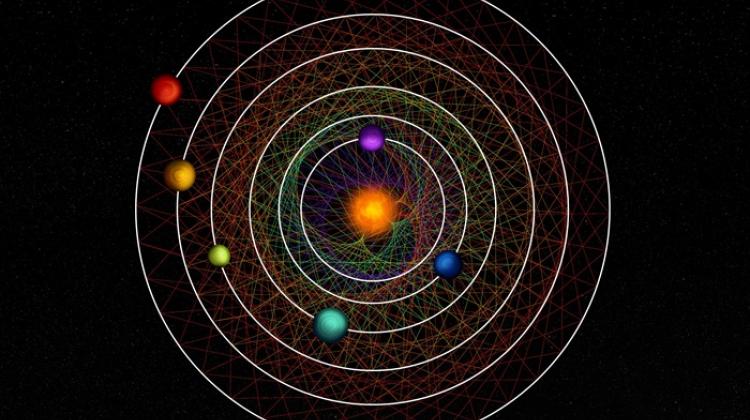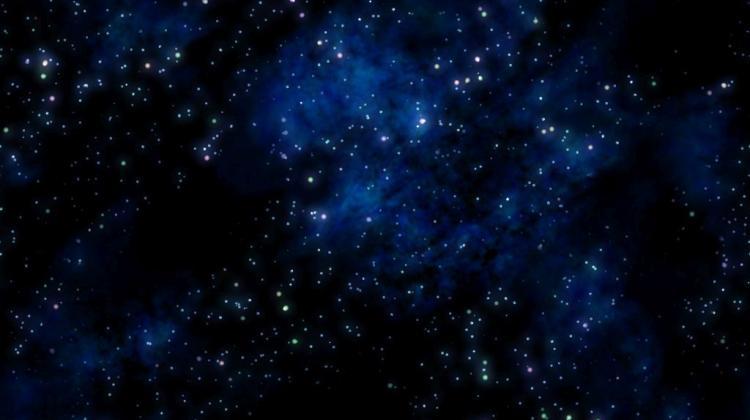Toruń astronomers discover super-Earth
 Artist's vision of the planetary system WASP-84. The super-Earth discovered by the Toruń astronomers is a dark dot visible against the background of the star's disc, captured during a transit phenomenon. The brownish globe visible in the distance is the previously known hot Jupiter. iFot. Press release / portal.umk.pl
Artist's vision of the planetary system WASP-84. The super-Earth discovered by the Toruń astronomers is a dark dot visible against the background of the star's disc, captured during a transit phenomenon. The brownish globe visible in the distance is the previously known hot Jupiter. iFot. Press release / portal.umk.pl
It is almost twice the size and fifteen times the mass of the Earth. It orbits its star in just 35 hours in a very tight orbit, causing its surface temperature to exceed one thousand degrees Celsius. The planet was discovered by the astronomers from Toruń, the Nicolaus Copernicus University reports.
UNEXPECTED COMPANION OF HOT JUPITER
The planet orbits the star known as WASP-84. Astronomers expect it to have no atmosphere due to its high temperature. Its rocky surface is therefore directly exposed to the intense stream of light, heat and wind emitted by its parent star.
There is another massive planet known in the same planetary system, somewhat similar to Jupiter, although it is located in a much closer orbit. Its orbital period is just over eight days, so it is classified as the so-called hot Jupiter.
'For a long time, these types of planets were thought to be loners devoid of massive planetary companions, which in turn directly influenced our ideas about the formation and evolution of planetary systems. However, this picture has changed over the last few years, as additional planets have started to be discovered in single planetary systems with hot Jupiters. We decided to contribute to this small revolution,’ says Dr. Gracjan Maciejewski, a professor at the Nicolaus Copernicus University and leader of the research group from the Institute of Astronomy at the Faculty of Physics, Astronomy and Computer Science.
The WASP-84 planetary system was one of ten systems that Weronika Łoboda studied as part of her BA project. 'I analysed star brightness measurements using observations obtained in 2021 with the Transiting Exoplanet Survey Satellite space telescope to detect small, periodic decreases in brightness. These can be caused by the cyclic obscuration of a part of the star's disc by a planet passing in its background. Astronomers call this phenomenon an exoplanetary transit,’ Łoboda says.
A HALF-PER MILLE DECREASE IN BRIGHTNESS IS THE KEY TO DISCOVERY
Weronika Łoboda discovered a faint and hardly perceptible signal in the noise when analysing the star WASP-84. Her calculations showed that the dips in brightness were only half a per mille of the recorded light flux.
'It must have been a really small planet and, in addition, located 16 times closer to its star than Mercury in the Solar System!,’ she says. The decline in brightness during the transit of the discovered super-Earth was extremely difficult to detect even through space telescopes. To detect it, the astronomers overlapped dozens of observations. This averaging allowed them to develop a model of the phenomenon and learn about the physical properties of the new planet.
Researchers who worked on verifying the discovery included Jan Golonka, a doctoral candidate at the Interdisciplinary Doctoral School 'Academia Copernicana'. He says the planet turned out to be a scaled-up Earth with an iron-rich core and a silicate mantle.
Among the thousands of known planets in hundreds of extrasolar planetary systems, WASP-84 is only the sixth case of a system with a hot Jupiter and an additional low-mass planet, and the third with the mass of such a planet determined.
The astronomers are confident that this is just the tip of the iceberg and discoveries of this type will become more frequent as detection techniques improve.
The discovery of Toruń astronomers was described in a paper published thanks to international cooperation with scientists from Germany and Spain. The source article is available here. (PAP)
PAP - Science in Poland
kol/ agt/ kap/
tr. RL
Przed dodaniem komentarza prosimy o zapoznanie z Regulaminem forum serwisu Nauka w Polsce.

















